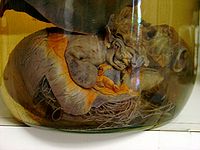
Photo from wikipedia
An exploratory study was carried out to assess the in vivo efficacy of different prototypes of subcutaneous implants containing ivermectin (IVM) for the prevention of canine Dirofilaria immitis infection. The… Click to show full abstract
An exploratory study was carried out to assess the in vivo efficacy of different prototypes of subcutaneous implants containing ivermectin (IVM) for the prevention of canine Dirofilaria immitis infection. The implants consisted of an ethylcellulose matrix containing IVM (3.0, 4.5, and 6.0 mg/implant; from 0.29 to 0.63 mg/kg bw) as active ingredient designed to release approximately 0.1 ng of IVM/mL in the plasma for at least 12 months. Six dogs were implanted on day −365. On day −12, three heartworm-free dogs were included in the study as a control group. All nine dogs were examined on day −7 and day 0 for circulating D. immitis microfilariae and by an antigen ELISA kit to confirm that the dogs were heartworm-free. The dogs were artificially infected with 75 D. immitis infective larvae (L3) each on day 0. Dogs in the control group were humanely euthanized on day 153 to verify the infectivity of the larvae, while implanted dogs were further examined for circulating D. immitis microfilariae and antigen on days 153, 195, and 246. The treated dogs were not necropsied. The pharmacokinetic profile of the IVM implant was assessed in plasma samples taken on day −364, then at different times until the infection day, and again on days, 15, 30, 60, 90, 120, and 153. Throughout the study, body weights were measured during clinical examination on days 0, 30, 60, 90, 120, and 153. At necropsy, all control dogs were found infected, each with 10–11 adult heartworms. Implanted dogs were negative at both microfilaria and D. immitis antigen examinations until day 246 (8 months from the infection). IVM plasma levels ranged 0.06–0.16 ng/mL on day 0 and remained stable until day 60, afterward they gradually decreased under the limit of quantification of the method. Throughout the study, no side effect was observed. On the basis of these results, it was possible to conclude that the different prototypes of implants were able to protect the dogs from D. immitis artificial infection for at least 12 months.
Journal Title: Parasitology Research
Year Published: 2017
Link to full text (if available)
Share on Social Media: Sign Up to like & get
recommendations!